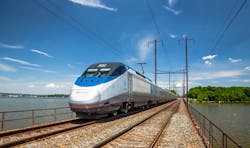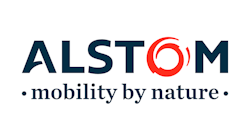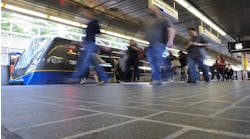The United States population is expected to grow by 70 million people over the next 30 years, while the majority of that will be concentrated in megaregions. One of those regions is the Northeast, which currently has 17 percent of the U.S. population in 2 percent of the land area.
From Boston, through New York City, Philadelphia and Baltimore to Washington, D.C., the Northeast Corridor (NEC) is the busiest rail line in the United States. The 457-mile corridor carries 750,000 trips each day, which is almost half of all passenger rail trips nationwide. Running through eight states, the corridor supports eight commuter railroads, four freight railroads and Amtrak.
Along the corridor, there are seven million jobs within a five-mile radius of an NEC; it moves a workforce that contributes $50 billion annually to the GDP.
The NEC is reaching the limits of its capacity and much of the infrastructure is in need of repair, with parts of its electrical and signal systems dating back to the 1930s and some bridges dating back to 1880.
Funding the NEC
Much of the NEC will see a change with $2.45 billion in federal loans to help pay for upgrades and new trains. It is the largest single loan in the U.S. Department of Transportation’s history. The loan is through the Federal Railroad Administration’s Railroad Rehabilitation and Improvement Financing (RRIF) program. This loan to Amtrak nearly doubles the dollar amount of loans from the RRIF program.
The loan will be used for upgrades between the New Carrollton and Baltimore stations and station and platform improvements at four of the busiest stations along the corridor. It will increase Acela service frequency, add new trainsets, improved fleet maintenance facilities to accommodate the new trains, and track capacity and infrastructure improvements.
Amtrak has 29 years to pay back the money with repayment beginning no later than 2022 and it will use revenue generated from growth in the NEC to pay it back.
“Under the RRIF Program, USDOT can defer debt service payments until the project funded is complete and generating revenue,” Amtrak Senior Vice President for Strategic Rail Initiatives Mark Yachmetz explained of the loan. “In the case of the Trainset Project, this deferral is for six years. By then all of the new Trainsets will be in operation. The funds Amtrak will use to meet the debt service on this loan will come from the growth in the operating margin of Amtrak’s Northeast corridor operations. Indeed, our projections show that the net operating revenue from the expanded capacity the trainsets provide will generate sufficient revenues to repay the loan.”
Next-Generation Trainsets
The 28 next-generation high-speed train sets, Avelia Liberty, replacing part of the Acela Express service, are being built by Alstom. It will generate more than 400 jobs at Alstom’s Hornell and Rochester, New York, facilities. With parts for the trainsets coming from more than 350 suppliers in more than 30 states, it will generate more than 1,000 jobs across the United States.
There are three aspects of Avelia Liberty that make it ideal for the NEC: articulated architecture, anticipative active tilting and compact power cars. Alstom Vice President, Marketing & Strategic Planning Scott Sherin explained the increased comfort, safety, speed and capacity achieved from those main features:
- The articulated architecture provides special joints between the passenger cars with the bogies affixed under them so there are no “gaps” or “weak links” between the passenger cars. This connects the entire train as a solid, rigid mass so the individual cars cannot move or bounce independently, resulting in a smoother ride for passengers and providing increased safety by mitigating the risk of a roll-over in the event of a derailment.
- The anticipative active tilting enables the train to tilt, or “lean into curves” so the train can maintain higher speeds through curves that are typically found in tracks not specifically designed for high speed, while also maintaining and even exceeding passenger comfort compared to non-tilting trains. By maintaining higher speeds throughout the entire trip, the trainsets are able to significantly reduce overall journey times.
- The compact power cars and miniaturization of key propulsion and electronics enable Avelia Liberty to provide more space for passengers on a 200 meter long trainset. As a result, Amtrak will be able to carry approximately 1/3 more passengers on the next generation Avelia Liberty Trainsets.
The new trains will operate at speeds of up to 160 mph, with the capability of traveling up to 186 mph, though it may only be along about 30 miles of the route under current conditions. Yachmetz said, “The capability of the trainset design and infrastructure improvements financed through the loan will allow Amtrak to raise speeds on several segments of the NEC up to 160mph.”
Beyond that, he said, there are many infrastructure improvements needed for higher speeds in the 186 to 220 mph range. “These improvements will require additional investments by Amtrak and the other users of the NEC. Amtrak notes that infrastructure investment is a stated priority of the incoming Administration. The next-generation trainsets will have the capability to operate at speeds of 186 mph (300 kph) in their initial configuration and thus will be able to take advantage of these improvements to the NEC over the next 30 years.”
The first prototype of the new trainsets will be ready in 2019. The first set of trains will begin carrying passengers in 2021 and all 28 will be in service by the end of 2022, when the current fleet is expected to be retired.
Sherin said, “The time spent aboard the Avelia Liberty will offer passengers a premium passenger experience, redesigned interiors and digital connectivity. This enhanced passenger experience, coupled with reduced travel times, more seating and reserved seating, and a smoother more comfortable ride, Avelia Liberty will be a catalyst for increased rail ridership on the NEC and help alleviate overall congestion within the NEC by reducing the number of flights between cities like Washington, D.C., New York City and Boston, and reduce the passenger automotive traffic on Interstate 95 that connects those cities.”
He continued, “The Acela service proves the rule consistently shown by economic models where for trip distances between 200 and 500 miles, when train travel takes less than 3 hours, rail will capture 50 percent of the market. And as trip times approach 2 hours, rail approaches 100 percent market share vs. other modes of transportation.
“Amtrak benefits from this dynamic today and generates approximately $500 million in year in profit on the NEC. Avelia Liberty will enable them to further reduce trip times and carry even more passengers. With this increase in passengers -- combined with the reduction in energy and maintenance costs -- will come significant increases in profitability and funds Amtrak can then reinvest in the NEC.”
Infrastructure Expansion & Updates
Washington Union Station 2nd Century Plan
An improvement plan to triple passenger capacity and double train capacity; it will expand station facilities over the next 20 years. It will potentially add several new lower-level concourses, multiple new entrances, wider platforms and new amenities and retail space.
The first set of improvements is the Concourse Modernization Project. The Claytor Concourse, Union Station’s intercity and commuter concourse, will double its capacity and will be modernized to enhance passenger comfort and accessibility. It is expected to be complete in 2019.
The plan includes a new transit-oriented development known as Burnham Place – a three million square foot mixed-use development over the existing rail yard. It will include retail, hotel, office and residential space, as well as open public green space.
Baltimore Penn Station
The aging station, built in 1911, is the 8th busiest station in Amtrak’s national system.
A Master Developer partner will be selected in 2017 to execute the phased redevelopment and expansion of the station and adjacent land.
Plans include critical near-term improvements, as well as planning for the future, such as replacement of the station roofs and drainage systems and structural shoring of the façade. In June of this year, Amtrak and the Maryland Transit Administration invested $1.2 million in a new backup generator system to ensure continuity of critical station operations during outages.
Philadelphia 30th Street Station
Completed in June of this year, the plan is a 35-year vision for the 40 acres of new open space and 18 million square feet of new development, led by Amtrak, Brandywine Realty Trust, Drexel University, the Pennsylvania Department of Transportation and the Southeastern Pennsylvania Transportation Authority.
Amtrak is working with its partners on a vision to create the area surrounding the multimodal hub into Philadelphia’s “next-generation neighborhood,” a place to live, work, learn and play.
The plan includes potential for $4.5 billion in private real estate investment, in addition to $3.5 billion for Drexel’s Schuylkill Yards project being developed by Brandywine Realty Trust. The projects are expected to generate $3.8 billion in city and state taxes and 40,000 new jobs.
Gateway Program
A comprehensive program of strategic rail infrastructure improvements that will double the passenger trains running under the Hudson River.
Since 2012, Amtrak has directed more than $300 million to the Gateway Program, which includes $74 million for planning and pre-construction work.
It will increase track, tunnel, bridge and station capacity, eventually creating four mainline tracks between Newark, Penn Station and a two-track Hudson River Tunnel.
The Hudson Tunnel Project
New Jersey Transit and Amtrak completed final design and federal environmental review to replace the swing-span Portal Bridge over the Hackensack River in New Jersey with a fixed-span bridge at an estimated cost of $1.5 billion. About 450 trains a day pass the current bridge and due to the aging mechanical components, it is a major source of delay for traffic.
The two-track replacement bridge, the Portal North Bridge, is designed as a high-level, fixed-span bridge.
A second two-track Portal South Bridge span is proposed as part of the program to double train capacity along this length of the corridor.
New York City
Moynihan Station and Penn Station expansions are incremental improvements to add capacity.
New Jersey High-Speed Rail Improvement Program
In 2012 Amtrak received $450 million in federal money to upgrade infrastructure along a 23-mile stretch of the corridor between Trenton and New Brunswick in New Jersey to accommodate 160 mph speeds and will serve as a model for the rest of the corridor.
The project will upgrade electrical power, signal systems, tracks and overhead catenary wires.
Amtrak is leading the project with its commuter partner, New Jersey Transit.
Current maximum speed in this stretch is 135 miles per hour. The benefits will be increased capacity, safety, reliability and speed.
The project is expected to be complete in June 2017.





